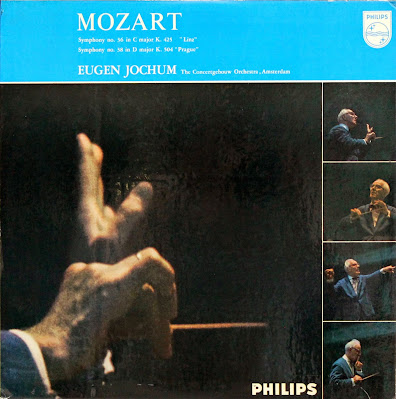Philips 835 111 AY: Solid, Forgotten Mozart from Eugen Jochum and the Concertgebouw
Mozart: Symphony No. 36 in C Major, K 425 "Linz", Symphony No. 38 in D, K 504 "Prague"
The Concertgebouw Orchestra, Amsterdam
Eugen Jochum, conductor
Pressing: UK, plum label
Date first published: 1962
Stampers:
4A 835111 2Y 2 670114C1 1
4A 835111 1Y 1 670115C1 A
Performance: 8/10
Sound: 7/10
Price range: $37-50 on popsike.com
Comments: When we think of Eugen Jochum the conductor, we generally associate his name with the works of the three B's: Beethoven, Brahms, and Bruckner. He recorded famous symphony cycles for all three composers and for Beethoven and Bruckner, more than one for different labels. Let's also not forget his marvelous set of Haydn's "London Symphonies" on Deutsche Grammophon (he also recorded a select few of these in the 1970s with the Dresden Staatskapelle for Philips) These Mozart recordings that he made with the Concertgebouw Orchestra for Philips in the early 1960s, however, have been largely forgotten, which is a real shame, because they're quite good. To my knowledge, there were two different LPs, this one with the "Linz" and "Prague" symphonies and one with the "Haffner" and "Jupiter" symphonies (with similar photos on the cover against a red background). The performances are lively and energetic, and the recorded sound is clear, rich, and full. I didn't pick up any noticeable distortion. Instruments have good separation and are spread over a nice and wide soundstage.
I just wanted to bring your attention to the Philips catalog numbering system. As you can see in the photo of the back cover, the record has two numbers, 835 111 AY and SAL3541. The first number with the 835 prefix was the Dutch catalog number, and the second with the SAL prefix was the UK catalog number. I have not done enough side by side comparisons between the Dutch and UK pressings, but from what I have heard, I would say that they both sound pretty great.







You should be able to decipher the matrix details.
ReplyDeleteThis has a 1968 Philips 'Festivo' reissue (SFM23024) with what appear the original matrices: 835 111 -1 / -1.
Philips Dutch mastered ('670')...sides are denoted by the prior '1Y / 2Y'
It received a new mastering (-1 /-1) using the 'Universo' matrix series when reissued 1971/2 as 6580 023.
Both UK pressed by Phonogram.
Useless information - free of charge!
Ahh yes, thank you for the tip! Thank you for the suggestion. I will have to check when I get home from work today!
DeleteUpdated the post with the matrix numbers. Looks like this may have been a Dutch master then ... we have 2Y/1Y followed by 670. Is that a valid deduction?
DeleteWaaaay too complex matrix info!
ReplyDeletedash 1
dash 2
1Y/2Y are the sides (1L/2L for mono)
670 denotes Dutch matrices (420 for UK mastered).
Everything after the '670' is probably similar to EMI/Decca stamper info (ie; the Festivo has 'C2' intead of 'C1').
The general point is the Festivo reissu (probably quite scace..) uses1962 matrices (albeit an alternate one for side 2).
Sampling #38 gave your result; it has 'spatial freedom' and lack of compresssion, although slightly bright.
Out of curiosity I sampled #38 in Bohm's DGG (138 111) - a Feb.1960 transfer and one from July '65.
These had less treble emphasis and were quite decent (the 1960 sightly less clear treble) and didn't suffer too much from DGG's 'Gramophony/blanketed'' sound - though the Philips has distinctly more 'presence'.
Must get round to listening properly to some of these LP's !!!
So, Philips used different masters for every country? I did not know that, I thought they used the same mastering everywhere. You just opened a can of worms my friend.
DeleteWhat are the best DG pressings? It seems the older ones have a copywright date and so I'd expect to see 1965. I don't know if I've seen a 1960 date in the dead wax.
ReplyDeleteYou know, that's a good question, and I'm not sure there is a good answer. The original blue tulips pressings are the ones that are collectible, but I am not convinced that this is all due to sound. I've got several blue tulips pressings. Some sound great (e.g. Kempff's Beethoven piano concerto box set, Karajan's Beethoven symphonies), others not so great. Some of the later non-tulips label pressings sound very nice and better than their tulips originals. Frankly, I think it's pretty hit or miss.
Delete